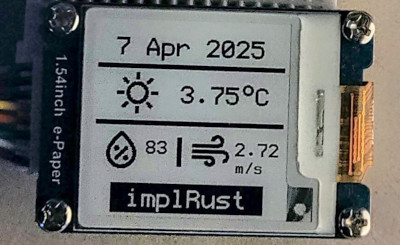Let the fun begin
In the main function, we will perform the usual setup steps like initializing the Wi-Fi stack, SPI device, and creating an instance of the Dashboard we defined earlier.
#[esp_rtos::main] async fn main(spawner: Spawner) -> ! { // generator version: 1.0.0 let config = esp_hal::Config::default().with_cpu_clock(CpuClock::max()); let peripherals = esp_hal::init(config); esp_alloc::heap_allocator!(#[unsafe(link_section = ".dram2_uninit")] size: 98767); let timg0 = TimerGroup::new(peripherals.TIMG0); esp_rtos::start(timg0.timer0); info!("Embassy initialized!"); let radio_init = &*lib::mk_static!( esp_radio::Controller<'static>, esp_radio::init().expect("Failed to initialize Wi-Fi/BLE controller") ); let rng = Rng::new(); let stack = lib::wifi::start_wifi(radio_init, peripherals.WIFI, rng, &spawner).await; let spi_bus = Spi::new( peripherals.SPI2, spi::master::Config::default() .with_frequency(Rate::from_mhz(4)) .with_mode(spi::Mode::_0), ) .unwrap() //CLK .with_sck(peripherals.GPIO18) //DIN .with_mosi(peripherals.GPIO23); let cs = Output::new(peripherals.GPIO33, Level::Low, OutputConfig::default()); let mut spi_dev = ExclusiveDevice::new(spi_bus, cs, Delay).unwrap(); // Initialize Display let busy_in = Input::new( peripherals.GPIO22, InputConfig::default().with_pull(Pull::None), ); let dc = Output::new(peripherals.GPIO17, Level::Low, OutputConfig::default()); let reset = Output::new(peripherals.GPIO16, Level::Low, OutputConfig::default()); let epd = Epd1in54::new(&mut spi_dev, busy_in, dc, reset, &mut Delay, None).unwrap(); let tls_seed = rng.random() as u64 | ((rng.random() as u64) << 32); let mut app = Dashboard::new(stack, epd, spi_dev); app.start(tls_seed).await; loop { Timer::after(Duration::from_secs(1)).await; } }
Clone the existing project
You can also clone (or refer) project I created and navigate to the wifi-webfetch folder.
git clone https://github.com/ImplFerris/esp32-epaper-weather/
cd esp32-epaper-weather
How to run?
We will need to pass the Wi-Fi name (SSID), Wi-Fi password, and Open Weather API key as environment variables when flashing the program onto the ESP32.
SSID=YOUR_WIFI_NAME PASSWORD=YOUR_WIFI_PASSWORD API_KEY=OPEN_WEATHER_KEY cargo run --release
If everything goes successfully, the e-paper display will flicker briefly to clear and render the content, and you should see the weather data displayed.
